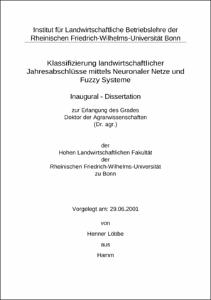Klassifizierung landwirtschaftlicher Jahresbeschlüsse mittels Neuronaler Netze und Fuzzy Systeme

Klassifizierung landwirtschaftlicher Jahresbeschlüsse mittels Neuronaler Netze und Fuzzy Systeme

| dc.contributor.advisor | Berg, Ernst | |
| dc.contributor.author | Löbbe, Henner | |
| dc.date.accessioned | 2020-04-03T12:13:46Z | |
| dc.date.available | 2020-04-03T12:13:46Z | |
| dc.date.issued | 2002 | |
| dc.identifier.uri | https://hdl.handle.net/20.500.11811/1686 | |
| dc.description.abstract | In der Jahresabschlussanalyse kommen zunehmend empirisch-statistische Methoden zum Einsatz. Hierbei handelt es sich um Verfahren, die Unternehmen nach Ereignissen bzw. Zuständen klassifizieren. Aufgrund ihrer Eigenschaften haben sich in den letzten Jahren insbesondere Neuronale Netze für diese Aufgabe durchgesetzt. Ihre überlegenen Eigenschaften gegenüber anderen empirisch-statistischen Instrumenten sind: Lernfähigkeit, Generalisierbarkeit und Fehlertoleranz. Deshalb werden in dieser Arbeit Neuronale Netze verwendet, um auf der Grundlage von Buchführungsdaten die zukünftigen finanziellen Zustände landwirtschaftlicher Unternehmen zu klassifizieren. Die Klassen des finanziellen Zustandes sind "finanziell gefährdet" und "finanziell gesund". Bei der Klassifizierung tritt das Problem auf, dass die Unternehmen nicht empirisch eindeutig der jeweiligen Klasse zugeordnet werden können. Deswegen werden die Klassen anhand der Kennzahlen Gesamtkapital-rentabilität, Fremdkapitalanteil und dynamischer Verschuldungsgrad definiert. Die beiden finanziellen Zustände sind des weiteren nicht eindeutig gegeneinander abgrenzbar. Deshalb erfolgt die Zuordnung der Unternehmen zur jeweiligen Klasse über ein Fuzzy System. Bei der Klassifizierung der zukünftigen finanziellen Zustände wird wiederum auf dieses Fuzzy System zurückgegriffen. Das Klassifizierungsmodell wird deshalb in die Abschnitte Neuronale Netze und Fuzzy Systeme unterteilt. Die Neuronalen Netze klassifizieren die Unternehmen nach den drei Kennzahlen, die den finanziellen Zustand definieren. Für jede Variable wird ein eigenes Neuronales Netz entwickelt. Hierbei handelt es sich jeweils um ein dreilagiges Multilayer-Perceptron mit einem Backpropagation-Lernalgorithmus. Über das Fuzzy System werden die klassifizierten Output-Variablen zusammengefasst. Durch diese Aufteilung des Modells werden die Eigenschaften der beiden Instrumente Neuronale Netze und Fuzzy Systeme miteinander kombiniert, da diese sich ergänzen. Neuronale Netze können strukturelle, vollständig unbekannte Systeme beherrschen, soweit deren Eingabe- und Ausgabeverhalten bekannt ist. Deshalb werden sie für den Teil des Modells verwendet, bei dem kein Wissen über die Zusammenhänge der Ausgangsdaten vorliegt. Im Gegensatz hierzu kann das Fuzzy System das vage Wissen über die Zusammenhänge der drei definierenden Kennzahlen über die Fuzzy Regeln mitberücksichtigen. Zur Überprüfung, ob die theoretischen Vorteile des Modells in der Praxis zu besseren Klassifizierungsergebnissen führen, wird ein Vergleich zwischen den Ergebnissen dieses Modells mit einer multivariaten Diskriminanzanalyse vorgenommen. Hierbei kann gezeigt werden, dass dieses Modell bessere Ergebnisse liefert als bisherige Verfahren. | en |
| dc.description.abstract | Classification of agricultural balance sheets by Neural Networks and Fuzzy Systems Empirical-statistical methods are increasingly used in the balance sheet analysis. These are methods which classify companies according to events and conditions respectively. In the recent years, especially Neural Networks have established themselves for this task on the basis of their qualities. Their superior attributes vis-a-vis other empirical-statistical instruments are: adaptability, generalization and fault tolerance. Therefore, in this study Neural Networks are used in order to classify the future financial states of agricultural companies on the basis of accounting data. The classes of the financial state are "financial distress" and "financial health". No unambiguous empirical assignment of the classes can be determined. For that reason, the classes are defined by the ratios: return on assets, debt-asset ratio and dynamic indebtedness (debt-cash flow ratio). The two financial states are furthermore not clearly definable against each other. Therefore, the assignment of the companies to the respective class is made via a Fuzzy System. This Fuzzy System is again used for the classification of the future financial states. Therefore, the classification-model is subdivided into the sections of Neural Networks and Fuzzy Systems. The Neural Networks classify the companies according to the three ratios which define the financial state. An individual Neural Network is developed for each variable. This is, in each case, a three-layered Multilayer-Perceptron with a Backpropagation-Algorithm. The classified output variables are summarised through the Fuzzy System. By subdividing the model, the attributes of the two instruments are combined, since they complement each other. Neural Networks can recognize structural, completely unknown systems, as far as their input and output behaviour known. For that reason, they are used for that part of the model for which no knowledge of the connections of the data is available. In contrast to the Neural Networks, the Fuzzy System can consider the vague knowledge of the connections of the three defining ratios by the Fuzzy rules. To examine whether the theoretical advantages of the model lead to better results in practice, the results of this model are compared with a multiple discriminant analysis. Thus it can be shown that this model delivers better classification results than previous methods. | en |
| dc.language.iso | deu | |
| dc.rights | In Copyright | |
| dc.rights.uri | http://rightsstatements.org/vocab/InC/1.0/ | |
| dc.subject | Jahresabschlussanalyse | |
| dc.subject | Neuranale Netze | |
| dc.subject | Fuzzy-Systeme | |
| dc.subject | FNN | |
| dc.subject.ddc | 630 Landwirtschaft, Veterinärmedizin | |
| dc.title | Klassifizierung landwirtschaftlicher Jahresbeschlüsse mittels Neuronaler Netze und Fuzzy Systeme | |
| dc.type | Dissertation oder Habilitation | |
| dc.publisher.name | Universitäts- und Landesbibliothek Bonn | |
| dc.publisher.location | Bonn | |
| dc.rights.accessRights | openAccess | |
| dc.identifier.urn | https://nbn-resolving.org/urn:nbn:de:hbz:5n-01998 | |
| ulbbn.pubtype | Erstveröffentlichung | |
| ulbbnediss.affiliation.name | Rheinische Friedrich-Wilhelms-Universität Bonn | |
| ulbbnediss.affiliation.location | Bonn | |
| ulbbnediss.thesis.level | Dissertation | |
| ulbbnediss.dissID | 199 | |
| ulbbnediss.date.accepted | 28.09.2001 | |
| ulbbnediss.institute | Landwirtschaftliche Fakultät : Institut für Lebensmittel- und Ressourcenökonomik (ILR) | |
| ulbbnediss.fakultaet | Landwirtschaftliche Fakultät | |
| dc.contributor.coReferee | Born, Dietrich |
Dateien zu dieser Ressource
Das Dokument erscheint in:
-
E-Dissertationen (1120)




